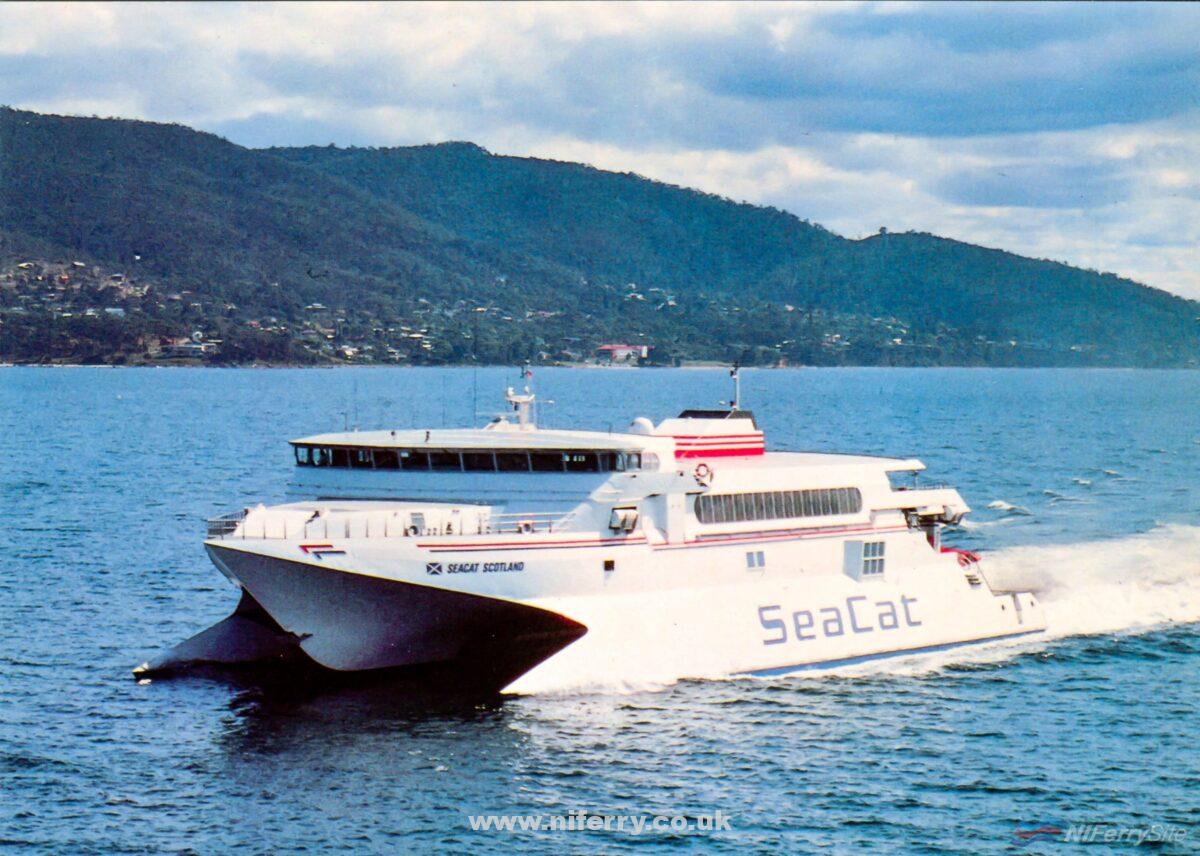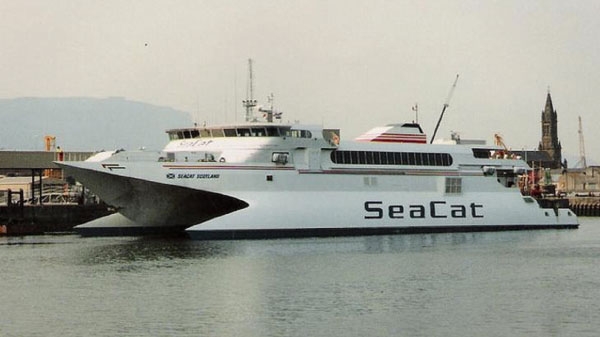Naxos Jet Fast Facts
| Current Name: Naxos Jet | Previous Names: SeaCat Scotland, Al Huda 1, Q-Ship Express, Shikra, Cyclades Express |
| Shipyard: International Catamarans (Incat), Hobart, Tasmania [AU] #28, | IMO Number: 8919518 |
| Current Operator: Seajets [GR] | Current Route: Piraeus - Naxos, Thira, and Mykonos [GR] |
| Length Overall: | Beam: |
| Passenger Capacity: 450 | Vehicle Capacity: 84 cars |
| Tonnage: | Sister-ships: Hoverspeed Great Britain, Hoverspeed France/Seacat Boulogne, Hoverspeed Belgium/Boulogne/Seacat Danmark, Seacat Tasmania/France/Calais |
The fifth and final of Hoverspeed’s 74m “Seacat” car carrying catamarans was built by International Catamarans (InCat) in Australia and launched as SEACAT SCOTLAND on the 29th October 1991.
All 5 of these vessels where built to the same “Mark 1” design and specification, with a further 4 built afterwards for other operators to modified specifications. Notably one of these was the 1993 built STENA SEA LYNX, which operated for Stena Sealink Line between Dun Laoghaire and Holyhead.
Sea Containers (Hoverspeed’s parent company) where outraged by this, as they had negotiated an exclusivity agreement with InCat for the UK. However this was circumvented by Stena Sealink as they chartered the vessel from Argentinian operator Buquebus – a scenario not covered by the agreement with InCat.
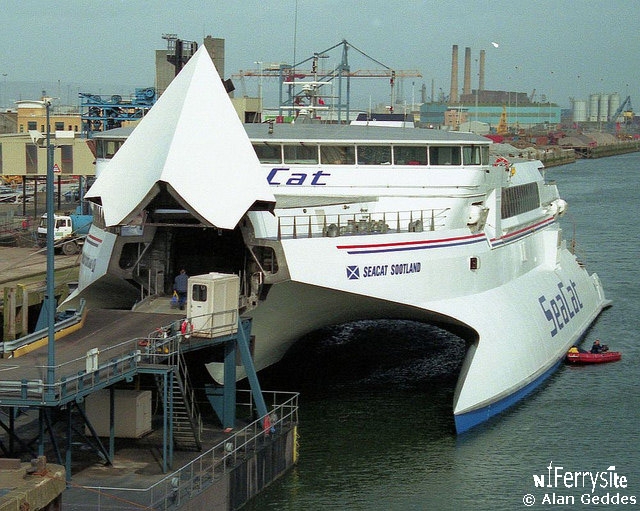
SEACAT SCOTLAND inaugurated the first fast ferry service between Northern Ireland (Belfast) and and the UK mainland (the Scottish port of Stranraer) on the 1st of June 1992, in competition with Sealink Stena Line and P&O’s conventional ferry services operating from Larne. Prior to this she operated from Dover to Calais from April 1992.
The SeaCat service boasted a crossing time of just 90 minutes when the service launched, despite operating on a much longer route than the competition. Like her sisters, SEACAT SCOTLAND was often marketed as “wave piercing” due to her pointed hulls.
The new service operated from the existing terminal at Donegal Quay which had been built in the 1960’s. This had been left vacant following the closure of the Belfast Car Ferries service to Liverpool.
In Stranraer, however, the service operated from a new purpose built facility provided by Dumfries and Galloway council, though the building itself was temporary in nature.
In late 1994 SEACAT SCOTLAND was chartered to Q-ships for 2 years to operate between Doha and Dubai, however this charter was short lived and she returned to her old service (and name) in March the following year.
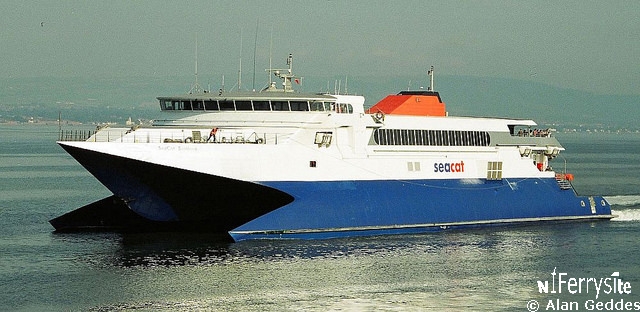
SEACAT SCOTLAND was also chartered out in 1997, leaving in September and returning the following April after a stint trading in South America between Colonia (Uraguay) and Buenos Aries.

From 2000 onwards, SEACAT SCOTLAND operated solely between Belfast and Troon after her operating company (Sea Containers Ferries Scotland) left Stranraer due to fierce competition from P&O and Stena Line. The Troon terminal consisted of 2 portable buildings right up until closure of the service in 2004.
In 2003 SEACAT SCOTLAND was again transferred to the Dover to Calais route (retaining her name) before she was laid up in 2004 following the failure of Hoverspeed’s ferry operations.
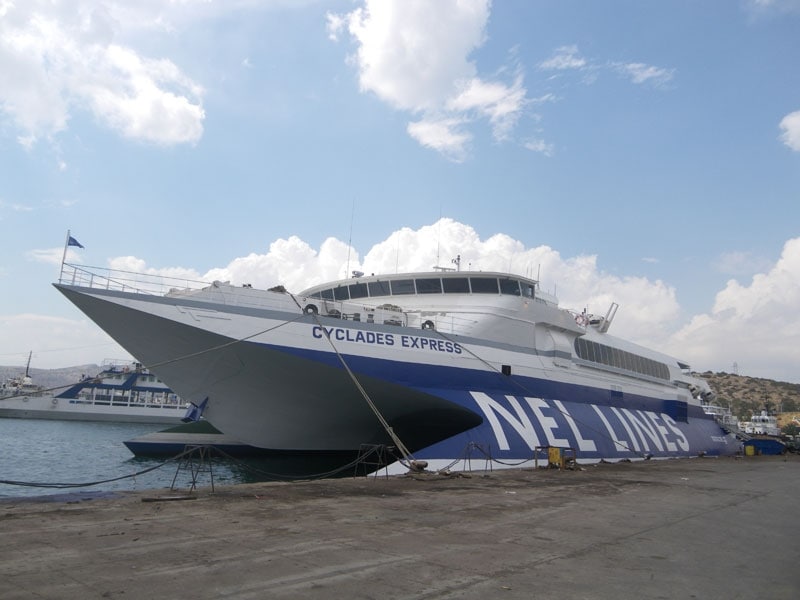
SEACAT SCOTLAND was refurbished in 2007 whilst under Greek ownership. She is currently named NAXOS JET having passed to Seajets in 2015. Following a period of layup after being towed to Drapetsona in February 2016, she has been noted during April 2018 operating between Piraeus and the Greek island ports of Naxos, Thira, and Mykonos. Of the five 74m vessels built by InCat for Seacat services, SEACAT SCOTALND was the only one to retain her original name throughout Sea Containers ownership.

Technical Data
|
Original name | Seacat Scotland |
|---|---|
|
Later names | AL HUDA 1, Q-SHIP EXPRESS, SHIKRA, CYCLADES EXPRESS, NAXOS JET |
| IMO Number | 8919518 |
| Design | Evolution Design |
Building Yard | InCat Tasmania Pty Ltd., Hobart, Tasmania |
Hull Number | 28 |
Year Completed | 1992 |
Owner (in NI Service) |
Sea Containers |
| Operator (in NI Service) | Sea Containers Ferries (Scotland) |
|
Classification | Det Norske Veritas – DNV +1A1 HSLC R1 Car Ferry “A” EO NAUT B (Later classified by RINA, after NI service) |
| In service (original) | 08/04/1992 |
| Call sign | 3EJW3 |
Length overall | 73.6m |
| Beam | 26m |
| Draft | 3.1m |
| Gross Tonnage | 3003 |
|
Construction | Subdivision – Each hull is divided into vented watertight compartments divided by transverse bulkheads. One compartments in each hull prepared as short- range fuel tanks and one as a long-range fuel tank. Fabrication – Welded aluminium construction using longitudinal stiffeners supported by transverse web frames and bulkheads. Design – Two slender, aluminum hulls connected by two main bridging beams and intermediate transverse sections with centre bow structure at fwd end. |
| Machinery | Main Engines – 4 x resiliently mounted Ruston 16RK270 marine diesel engines at 4050 kW each. Water Jets – 4 x Lips LJ115DX. Two waterjets configured for steering and reverse. Transmission – direct drive. Ride Control – A ‘Maritime Dynamics’ active ride control system is fitted to maximise passenger comfort. The system combines active trim tabs aft and optional T-foil with active fins located at the forward end of each hull. Alternator – 4 x Caterpillar 3306 142kw (nominal) marine, brushless, self- excited alternators |
Power(Max) | 16,200kW |
| Speed (Max/Operational) |
34kts |
|
Capacity | 450 passengers and 84 cars. |
| Cargo Access | Bow door/visor and stern doors leading directly onto the car deck |
| Flag (whilst serving NI) | Bahamas (Nassau), UK (Stranraer) |
Photographs

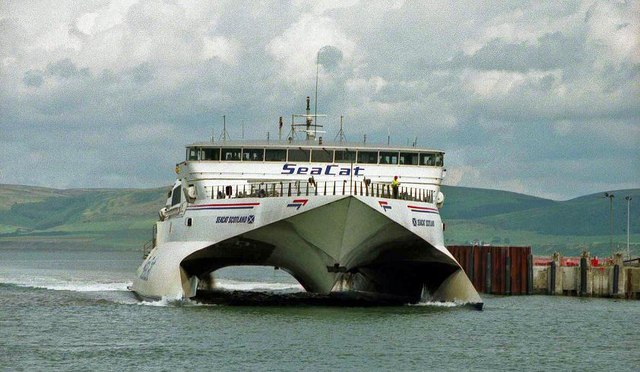

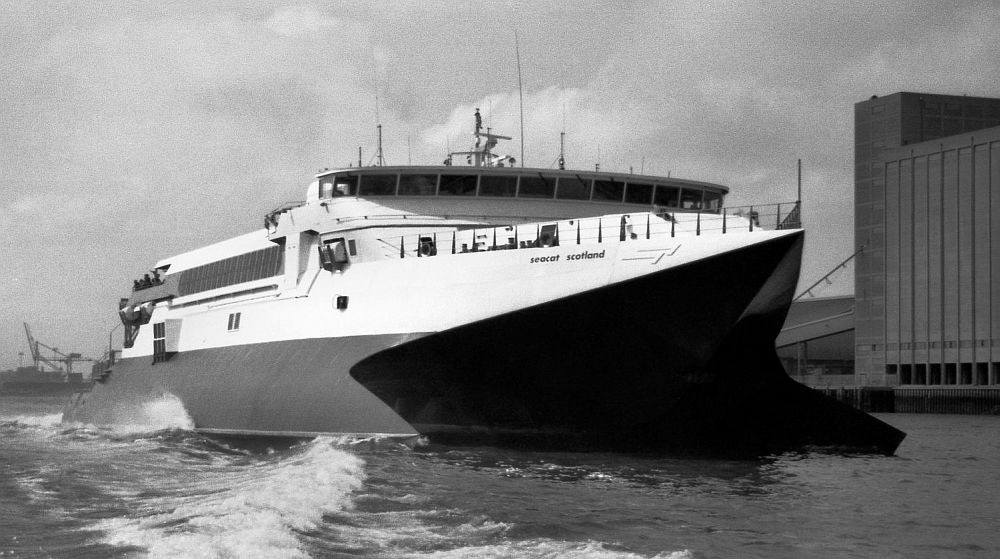
Originally published 9 Jun 2015
Latest update 26 Jan 2021
